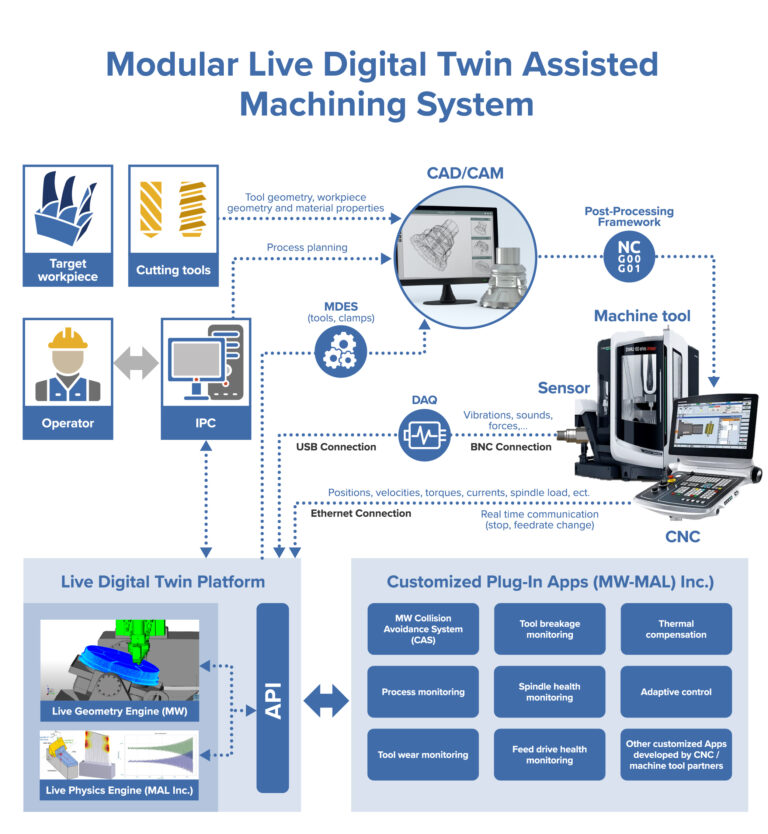
By Dr. Yavuz Murtezaoglu
Software-Defined Cars Are Already Here: Are Software-Defined CNC Machines Now Entering Job Shops?
In the first article, I shared my 30 years’ experience in simulating CNC machines and in the second I looked at how CNC machines with integrated collision avoidance systems prevent crashes and made the bold claim that they might even eliminate all crashes by 2030.
This final article takes us to the latest evolution in simulation, where we talk about a simulation running live inside the CNC control, enabling the machine to become fully automated.
What is the best name for this type of simulation? Other industries use the term Digital Twin, which captures its essence well. As everything occurs in real time, I would like to call it a “Live Digital Twin”.
The Rise of Digital Twins
The huge success of NVIDIA in driving artificial intelligence (AI) with their chips and software platforms has been a catalyst for Digital Twins which are now a familiar feature of our industry. The Digital Twin is a virtual copy of machines and factories that enables AI to find optimal manufacturing solutions without having to perform any actual machining. With the Digital Twin, we can machine millions of scenarios virtually on the cloud and train the AI engine to find the best machining strategies for any given job. The results can help CNC operators, engineers and CAM programmers make quicker, smarter decisions that save time and costs on the shop floor.
We have only just begun tapping into the potential of Digital Twins for training AI engines. It is an exciting prospect. The global Digital Twin market is expected to grow annually by 36.9% across all industries, reaching a value of USD 412.0 billion by 2033[1]. AI will play a central role along with cloud-based solutions. As the technology matures, we can look forward to the developments it will bring to digital manufacturing.
But even without training the AI, Digital Twins are already generating value of their own and it is this immediate value that I would like to focus on.
Going Live with Digital Twins
A real time Digital Twin, what I call a “Live Digital Twin (LiDiT)”, would run in parallel with the CNC machine, and would even run one second ahead of the machining process. It knows every detail about the positions of the machine’s components at every millisecond. It knows which tool is being used, the in-process workpiece, the work holding, the material and the physical capabilities of the machine. With this knowledge, the LiDiT can stop the machine before a collision occurs, as I described in my previous article. It also has access to cutting process data, such as the spindle current, and feed drive data from the sensors and interprets this along with the calculated machine positions to create a complete and exact reconstruction of the machining physics.
The Live Digital Twin would perform all this in real time while the machine tool is running, making it a highly effective and constantly alert guardian that accurately monitors the cutting process and detects any anomalies, such as tool breakage, excessive tool wear or unexpected high loads on the tool. It can then take active measures to protect the machine, for example, adjusting the feed rate to bring cutting forces within the specified limits for the tool. Sometimes it will stop the machining process altogether when excessive forces cannot be corrected. Health monitoring extends to the spindle and feed drives, providing comprehensive coverage for safer, more efficient and more cost-effective machining.

Its ability to monitor the physical cutting process in milliseconds with a one second look-ahead into the future is the essential basis for automation. Imagine a batch of produced parts that is unusable due to tool breakage, undetected chatter and other process related issues – a nightmare scenario for any machine shop. This is all too common in “high mix – low volume” environments where many different parts are produced in small quantities, making it impractical and time-consuming to set up and apply automated process monitoring for each job. Instead, operators need to constantly monitor the machining process which limits the shop’s ability to implement 24/7 production.
With high-volume jobs that run for several days or weeks, setting up and running a monitoring system is somewhat easier, but the system still needs careful and accurate programming and configuration to ensure optimal operation.
In either scenario, the challenge facing the monitoring system is the same – to reliably detect anomalies while not raising any false alarms that would unnecessarily stop a running production line.
The Live Digital Twin Platform
The Live Digital Twin offers the ideal platform for building such a system. To be truly effective, it requires two essential modules:
- A live geometry engine with exact geometric knowledge of the shape and position of all machine components.
- A live cutting physics engine to accurately calculate the forces, tool bending and other physical variables in the machining process.
Together, these two modules form the Live Digital Twin Platform that would allow different applications like collision avoidance, process monitoring, process optimization and a host of future modules to be integrated as plug-ins.
Each plug-in would have access to the live data supplied by the geometry and cutting engines, paving the way for a wide range of powerful, new applications. As more modules are developed and integrated, the value and effectiveness of the LiDiT grows.
Why do we call this a platform? Very simple – machine tool builders and cutting tool manufacturers are the machining experts. They know exactly which applications and modules they need and how the system should be configured and customized to run with their own solutions. The Live Digital Twin Platform would enable them to do this – it is designed to work with all major CNC control brands and machine tools and allow solution providers to develop and add their own applications as required.
To achieve its full potential, the platform would have to be open, neutral and scalable:
Open – to seamlessly handle a wide variety of data formats from multiple sources.
Neutral – to enable solution providers to develop innovative applications and get them to market faster without bearing the cost of maintaining the underlying platform.
Scalable – so that it grows naturally, allowing machine tool builders and CNC control makers to focus on delivering diverse solutions that drive real value for their end users.
As an independent technology provider, ModuleWorks is ideally placed to develop and maintain such a platform. Our experience with designing and stewarding MDES (Manufacturing Data Exchange Specification) means we understand the role of technology as an enabler that not only reduces development costs for everyone, but also fosters cooperation and brings the manufacturing industry closer together. The Live Digital Twin Platform is the next logical step in this direction – a platform where collaboration, efficiency and forward-thinking solutions can thrive, shaping the future of manufacturing.
The Future is Coming
Is this a dream, a vision or a reality? We have been working on many individual parts of this solution and are looking forward to presenting the Live Digital Twin Platform to our partners soon.
What about integrating and training the coming AI engines? As a platform designed to work with different modules, applications, machine tools and solutions, the LiDiT is ready to incorporate future innovations in AI, making it a springboard for developing truly automated and intelligent manufacturing systems.
So, watch this space. Software-driven CNC machines may well be on the road sooner than you think!
About ModuleWorks
ModuleWorks is at the forefront of digital manufacturing software, playing a key role in enabling the efficient production of increasingly complex parts in an environmentally sustainable way. As a strategic partner to leading CAD/CAM vendors, CNC control makers, machine tool builders and cutting tool manufacturers, ModuleWorks develops software that powers solutions throughout the manufacturing industry which contributes to 16% of global GDP worth $16 trillion per year.
Founded in 2003, ModuleWorks has grown to over 200 developers and already invested 2000 person-years of software development in toolpath and simulation technologies that form the core of manufacturing processes. In the CAD/CAM area alone, ModuleWorks has a market share of 90%, enhancing the performance and quality of over 500,000 installed seats of CAD/CAM and CNC software worldwide. With a comprehensive portfolio of cutting-edge software components and the capacity to address emerging and niche technologies like AI, cloud, automation, additive, robotics and digital dentistry, ModuleWorks is committed to shaping the future of digital manufacturing with its partners, empowering the industry to Get There Faster.